The Intel Haswell-E CPU Review: Core i7-5960X, i7-5930K and i7-5820K Tested
by Ian Cutress on August 29, 2014 12:00 PM ESTGaming Benchmarks
One of the important things to test in our gaming benchmarks this time around is the effect of the Core i7-5820K having 28 PCIe 3.0 lanes rather than the normal 40. This means that the CPU is limited to x16/x8 operation in SLI, rather than x16/x16.
F1 2013
First up is F1 2013 by Codemasters. I am a big Formula 1 fan in my spare time, and nothing makes me happier than carving up the field in a Caterham, waving to the Red Bulls as I drive by (because I play on easy and take shortcuts). F1 2013 uses the EGO Engine, and like other Codemasters games ends up being very playable on old hardware quite easily. In order to beef up the benchmark a bit, we devised the following scenario for the benchmark mode: one lap of Spa-Francorchamps in the heavy wet, the benchmark follows Jenson Button in the McLaren who starts on the grid in 22nd place, with the field made up of 11 Williams cars, 5 Marussia and 5 Caterham in that order. This puts emphasis on the CPU to handle the AI in the wet, and allows for a good amount of overtaking during the automated benchmark. We test at 1920x1080 on Ultra graphical settings.
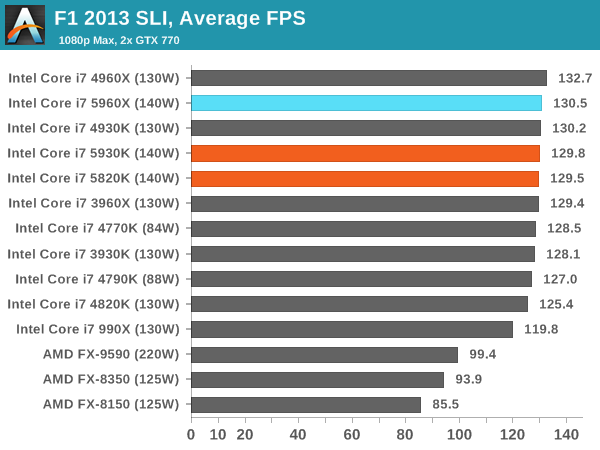
Nothing here really shows any advantage of Haswell-E over Ivy Bridge-E, although the 10% gaps to the 990X for minimum frame rates offer some perspective.
Bioshock Infinite
Bioshock Infinite was Zero Punctuation’s Game of the Year for 2013, uses the Unreal Engine 3, and is designed to scale with both cores and graphical prowess. We test the benchmark using the Adrenaline benchmark tool and the Xtreme (1920x1080, Maximum) performance setting, noting down the average frame rates and the minimum frame rates.
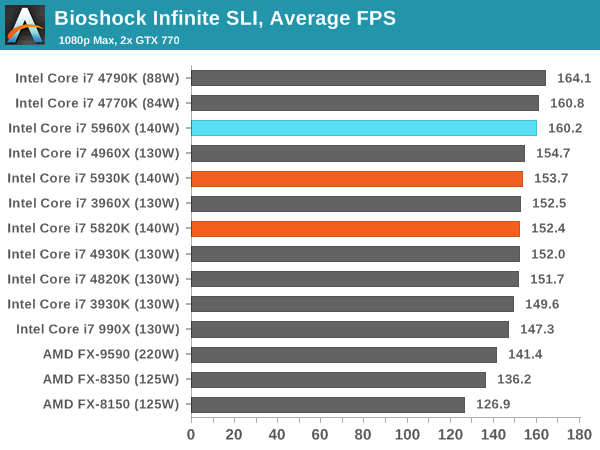
Bioshock Infinite likes a mixture of cores and frequency, especially when it comes to SLI.
Tomb Raider
The next benchmark in our test is Tomb Raider. Tomb Raider is an AMD optimized game, lauded for its use of TressFX creating dynamic hair to increase the immersion in game. Tomb Raider uses a modified version of the Crystal Engine, and enjoys raw horsepower. We test the benchmark using the Adrenaline benchmark tool and the Xtreme (1920x1080, Maximum) performance setting, noting down the average frame rates and the minimum frame rates.
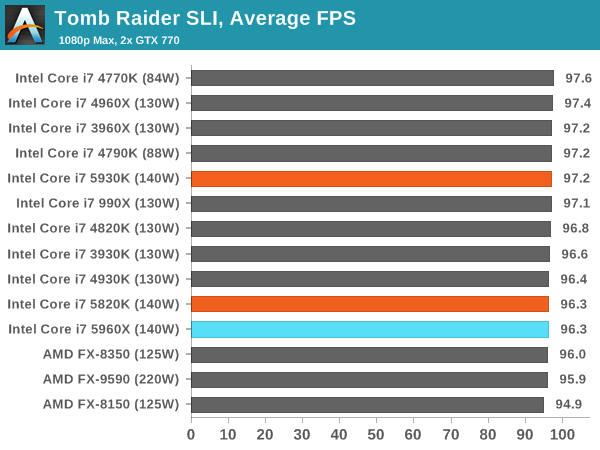
Tomb Raider is blissfully CPU agnostic it would seem.
Sleeping Dogs
Sleeping Dogs is a benchmarking wet dream – a highly complex benchmark that can bring the toughest setup and high resolutions down into single figures. Having an extreme SSAO setting can do that, but at the right settings Sleeping Dogs is highly playable and enjoyable. We run the basic benchmark program laid out in the Adrenaline benchmark tool, and the Xtreme (1920x1080, Maximum) performance setting, noting down the average frame rates and the minimum frame rates.
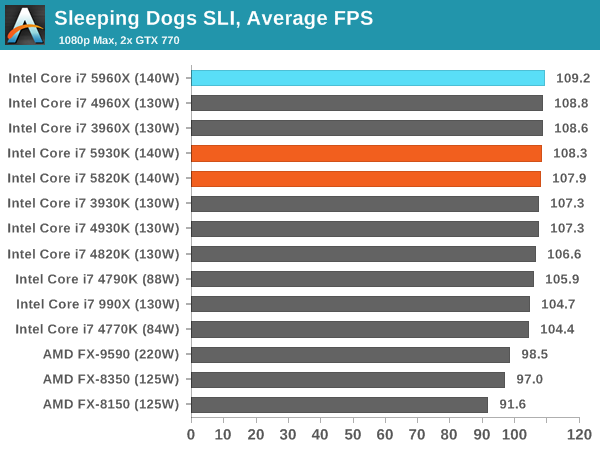
The biggest graph of CPU performance change is the minimum frame rate while in SLI - the 5960X reaches 67.4 FPS minimum, with only the xx60X CPUs of each generation moving above 60 FPS. That being said, all the Intel CPUs in our test are above 55 FPS, though it would seem that the 60X processors have some more room.
Battlefield 4
The EA/DICE series that has taken countless hours of my life away is back for another iteration, using the Frostbite 3 engine. AMD is also piling its resources into BF4 with the new Mantle API for developers, designed to cut the time required for the CPU to dispatch commands to the graphical sub-system. For our test we use the in-game benchmarking tools and record the frame time for the first ~70 seconds of the Tashgar single player mission, which is an on-rails generation of and rendering of objects and textures. We test at 1920x1080 at Ultra settings.
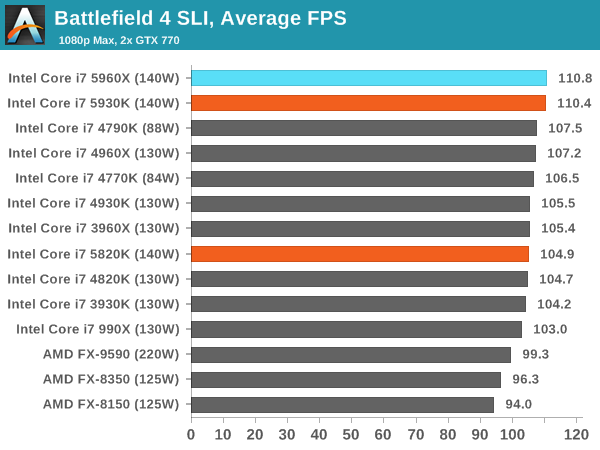
Battlefield 4 is the only benchmark where we see the 5820K with its 28 PCIe lanes down by any reasonable margin against the other two 5xxx processors, and even then this is around 5% when in SLI. Not many users will notice the difference between 105 FPS and 110 FPS, and minimum frame rates are still 75 FPS+ on all Intel processors.















203 Comments
View All Comments
akLuckyCharm - Saturday, August 30, 2014 - link
Thank you Anand Tech for showing performance with ALL of the cpus overclocked as apposed to only one chip overclocked and the rest at stock. This makes the comparison much more fair and realistic.MrSpadge - Saturday, August 30, 2014 - link
I really like the analysis of performance per clock. It really helps me to judge CPU performance. However, why do you disable HT for these tests? All the CPUs considered have it, and on average it boosts performance. And most importantly:"Haswell bought... two new execution ports and increased buffers to feed an increased parallel set of execution resources... Intel doubled the L1 cache bandwidth."
Right. Which means Haswell may very well see better performance improvements from enabling HT than older CPUs. This could be very relevant for the workloads which people should run on these 6 and 8 core monsters. And by that I'm not talking about gaming ;)
vision33r - Sunday, August 31, 2014 - link
Most people don't need this setup because the only thing here is really your Haswell processor with couple of extra cores, a few different parts for DDR4, and a little bump here in L2 and that's it. Games don't need all of these changes because most games today are sophisticated enough to utilize them.I can certainly see that my VM and rendering machine will love the new 5960X and DDR4 but it's not worth investing in new platform when it just came out.
Anyone that does high end AV content creation will see a big bump if you got the money to spend on it.
HongKonger1997 - Sunday, August 31, 2014 - link
So if I only game with computer, my 3960X is still good?MrSpadge - Sunday, August 31, 2014 - link
Of course. Even a Sandy Bridge i5 would easily do the jpb, a 3960X is actually complete overkill.Artemis *Seven* - Sunday, August 31, 2014 - link
All great benchmarks except for the gaming ones. It's pretty common knowledge that Geforce cards like to handle almost everything "in-house" whereas AMDs tend to dump a big chunk of their workload onto the CPU. All I'm saying is that I'd love to see a gaming benchmark redone with R9's - I'm betting it would show the differences between these processors in games better - if there are actually any :Dmlambert890 - Monday, September 1, 2014 - link
the differences are minor with PURE cpu tests. sandy e to ivy e is about 5% ipc gain. ivy e to hw e is another 8% or so, but it suffers a 10% oc ceiling deficit against them and it has higher latency ram to boot.unless your workload truly has 8 threads or you multitask to the point you are saturating 6 fast cores this is a non upgrade coming from sandy or ivy
woj666 - Sunday, August 31, 2014 - link
It's curious why they used the dud 5960 results for overclocking vs the one that kept up to the 4790 in overclocking. I detect some 4 core bias here.A 5960@4.0 will run at the same temperature as a 4790@4.0.
mlambert890 - Monday, September 1, 2014 - link
double the active cores at same clock rate equals lots more power which equals lots more heat. notice the tdp values?faster - Sunday, August 31, 2014 - link
I might finally upgrade my work computer. I'm running an i7 920 with 8gb memory and a 256 GB SSD drive. I need that extra power for word processing, emailing, and surfing the web. Oh wait, no I don't. For the basic computer user, computers have been fast enough for many years.For my home gaming machine, I don't see a reason to upgrade my 4770k.